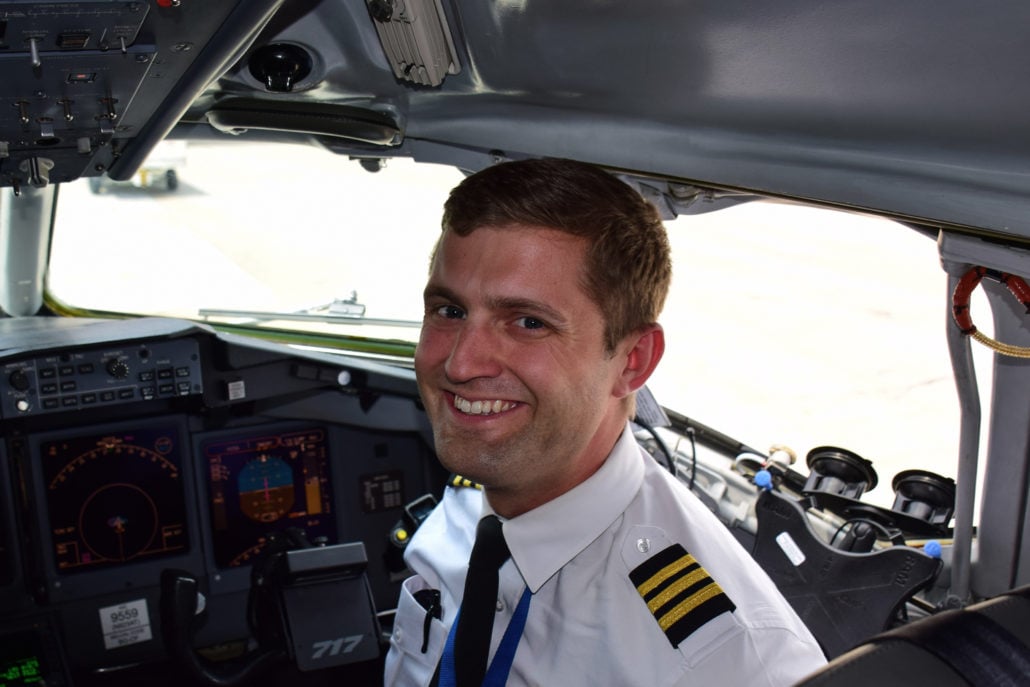
In our Ask a Pilot series, pilot Spencer Marker answers one of your aviation-related questions each week. See past installments here and submit your own to whitney@johnnyjet.com.
The question
How do you become an airline pilot?
The answer
As a pilot in uniform, there are a handful of questions I seem to get on a regular basis from the traveling public. Some are common such as, “What time will we land?” However, my favorite question, and the one I love to answer most, is “My son/daughter/relative loves airplanes. How do you become an airline pilot?” And the answer isn’t quite as as straightforward as you’d think.
There are 590,039 certificated pilots in the United States, and every pilot’s journey starts with a story. Whether it’s the grandfather who used to take you up in his old airplane, or always booking the window seat on an airline when you traveled, each story is unique!
My passion for aviation started on the way home from a family trip when I was eight-years old. We had a layover in the Pittsburgh International Airport (when US Air had a hub there). I remember pressing my hands against the windows and looking outside. I was awestruck. The movement of the airplanes scurrying back and forth was enthralling to me. I decided in that moment what I wanted to do; I wanted to be an airline pilot.
I was lucky enough to have parents who would drive me to the municipal airport in Topeka, KS, just to watch small airplanes take off and land. At the age of 14, I took my first introductory flight with an instructor in a small, two-seat Cessna 152. After we landed, there was no doubt about what I wanted to do for my career.
Take an intro flight
An introductory flight is a good first step for someone considering a career in aviation. These beginner lessons include roughly thirty minutes of ground school, where you will learn fundamental aerodynamics and aircraft control. After covering the basics, you step into a real airplane with a qualified flight instructor and go flying. And yes, you will get fly the airplane! These starter flights are offered by flight schools around the country (to find one close to you, click here). And even if you don’t plan on becoming a professional aviator, getting into the sky and experiencing flight with your hands on the controls is an unforgettable experience.
The Experimental Aircraft Association (EAA) also offers aspiring aviators great introductory options with the Young Eagle and Eagle Flight programs. These programs pair interested aviators with a licensed pilot for a free intro flight.
If after an introductory flight you find that an aviation career is for you, great! At this point there is a choice to make: to pursue an aviation career in the military or as a civilian. Both choices can eventually lead you to the flight deck of an airliner, but have slightly different means of getting there.
The military path
Pilots choosing to enter the military to pursue their flying dreams have the advantage of Uncle Sam paying for their training. In return, these pilots commit themselves to around 10 years of service to the military. These pilots receive rigorous and top-notch training in exchange for their service. While the commitment may be daunting, these aviators go on to long and fruitful military careers before entering the airline world. In the past, most pilots selected by the airlines have come from the armed forces, but within the last decade that trend has shifted.
The civilian path
Most pilots entering the airlines these days come from a civilian background. Pilots choosing to pursue an aviation career through a civilian path are also required to undergo long hours of academic and flight training. Civilian training options range from rigorous structured training courses through universities to flight training offered at the local airport. Every option has benefits and drawbacks based on schedule and intensity of the training. Personally, I chose to pursue aviation through a university.
Civilian pilots progress through their training by building hours (flight time) and attaining different licenses that allow them to do different things. Each level has minimum flight experience requirements (flight hours), a written test and a practical test, or checkride. During these checkrides, students must pass a thorough oral and practical test with an FAA Examiner. These tests evaluate a student’s depth of knowledge and skills required to accomplish certain tasks in an airplane. And as a pilot progresses through their training, these tasks become more and more challenging. These tests continue for the duration of an aviation career and while they are stressful, focused study and good training make passing them easier. In fact, airline pilots are evaluated on a regular basis to make sure their skills stay sharp!
In the end, all the rigorous training and lofty requirements are meant to create safe pilots. And regardless of whether your interest in aviation is simply for pleasure or to pursue a career, the greatest reward for all the hard work is simply guiding that airplane into the air. I won’t sugarcoat it: Flying is a challenging pursuit that requires discipline and perseverance. And for those of us lucky enough to put on our uniform and step into the cockpit every day, we wouldn’t have it any other way.
If anyone has a burning aviation question or something you would like cleared up, drop us a line at Whitney@johnnyjet.com to get your question featured in an upcoming “Ask a Pilot” column.
Clear skies and tailwinds,
—Spencer





Learning to fly is the fun but becoming an airline pilot requires a lot of hard work and plenty of learning procedures. Thank you for sharing this post!